
Pelvetiopsis limitata
Dwarf Rockweed, Small Rock Weed, Spindle-shaped Rockweed
Field interactions exclusively at:
Botany Bay, Juan de Fuca Strait, B.C. (We’ve found this seaweed nowhere else yet)
3 December 2021, commencing at 3:00pm, as the tide was receding to a low of 1.0 feet at 6:21pm this evening.
4 December 2021, commencing at 3:00pm, as the tide was receding to a low of 0.3 feet at 7:08pm this evening.
Tides:
3:00pm, 3 Dec 2021, 5.3 feet (measured at Port Renfrew Tidal Station)
3:00pm, 4 Dec 2021, 7.2 feet (measured at Port Renfrew Tidal Station)
Conditions 3 Dec 2021: Mainly clear with 10% cloud cover, 3˚C, wind SE 10km/hr, moderate westerly swell, light chop, humidity 70%.
Conditions 4 Dec 2021: Mainly clear with 10% cloud cover, 4˚C, wind light & variable, moderate westerly swell, light chop, humidity 80%.
Note: The second day, although the weather stats don’t really shout it out, was a gentler day. The rawness to the air was gone and the surf, though still very present, had lost its intensity and was milder.
Moon 4 Dec 2021 at 3:00pm: Waxing Crescent (approx.. 20 hours into this phase at the time of interaction); Previous Phase, New Moon, 3 Dec 2021 at 11:43pm PDT: Next Phase, First Quarter, 10 Dec 2021 at 5:35pm PDT.

Figure 1: Backlit small Pelvetiopsis limitata algae reach upwards from the barnacle-strewn rocky substrate with their dichotomously branched “peace” symbol look. Botany Bay, Juan de Fuca Strait, B.C., Canada. December 4, 2021. Photo ID 27361 ©Seaweedwhisperings.com
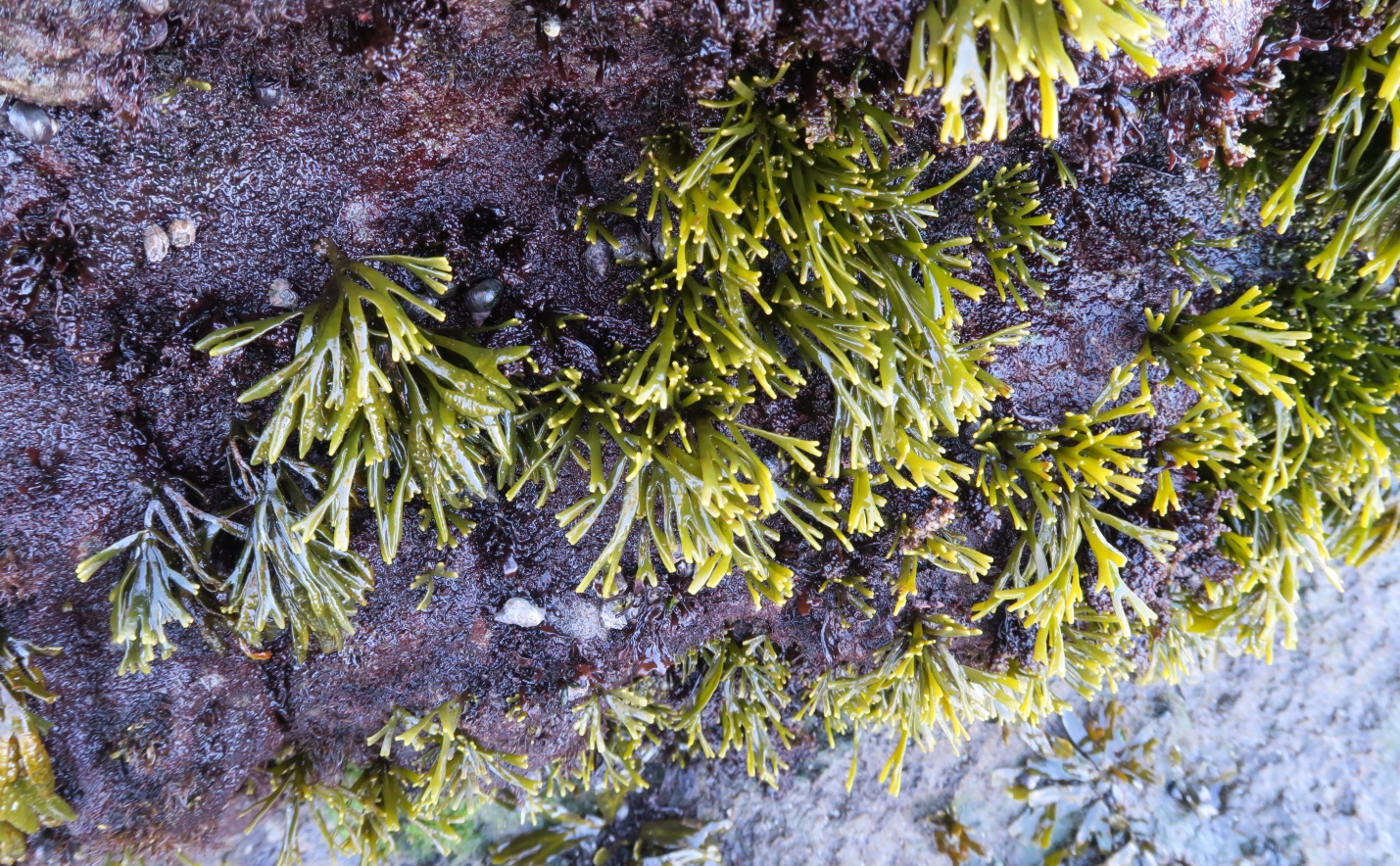
Figure 2: This view reveals the algal population while looking down from the top of the face of a rock outcropping. Rhodochorton purpureum, Mastocarpus sp, and Pelvetiopsis limitata have all made a home here on this shaded north exposure that is also on the lee side of the surf. Botany Bay, Juan de Fuca Strait, B.C., Canada. December 4, 2021. Photo ID 27362 ©Seaweedwhisperings.com
Person 1:
Flopped lazily over rocks, sheltered from main impact of the surf.
Reminds me of branching and spreading habit of Lycopodium clavatum.
Coarse feel when running my palm over Pelvetiopsis clusters.
December 3rd – heavy surf; December 4th – moderate surf. Pelvetiopsis at low tide was away from the surf and totally oblivious to it.
Gentle morning at Snuggery Cove where we compiled our impressions.
Likes to gather in groups where they all look rather similar to each other.
Low on sexual energy – some individuals eventually get around to it.
Groups of Pelvetiopsis are conspicuous – bright green-yellow hued. But the individuals don’t stand out unless viewed up close.
Shiny, glazed appearance to the thalli.
Clusters we viewed were on the north, dark, shaded side.
Forked blades are rounded; in fact, this seaweed has no sharp edges. Doesn’t need to impress anyone.
However, there is a “reaching out” quality of the thalli. Perhaps Pelvetiopsis would like to be recognized for who they are without having to prove anything, without having to prove their worth.
Difficult to get to know an individual – the group effect overwhelms or obfuscates the individual. There is an aura of cloudiness, perhaps more like a highly aromatically scented marijuana smoke haze at a 1960’ – 70’s party; the haze clouds things but in an “everything’s fine” kind of way.
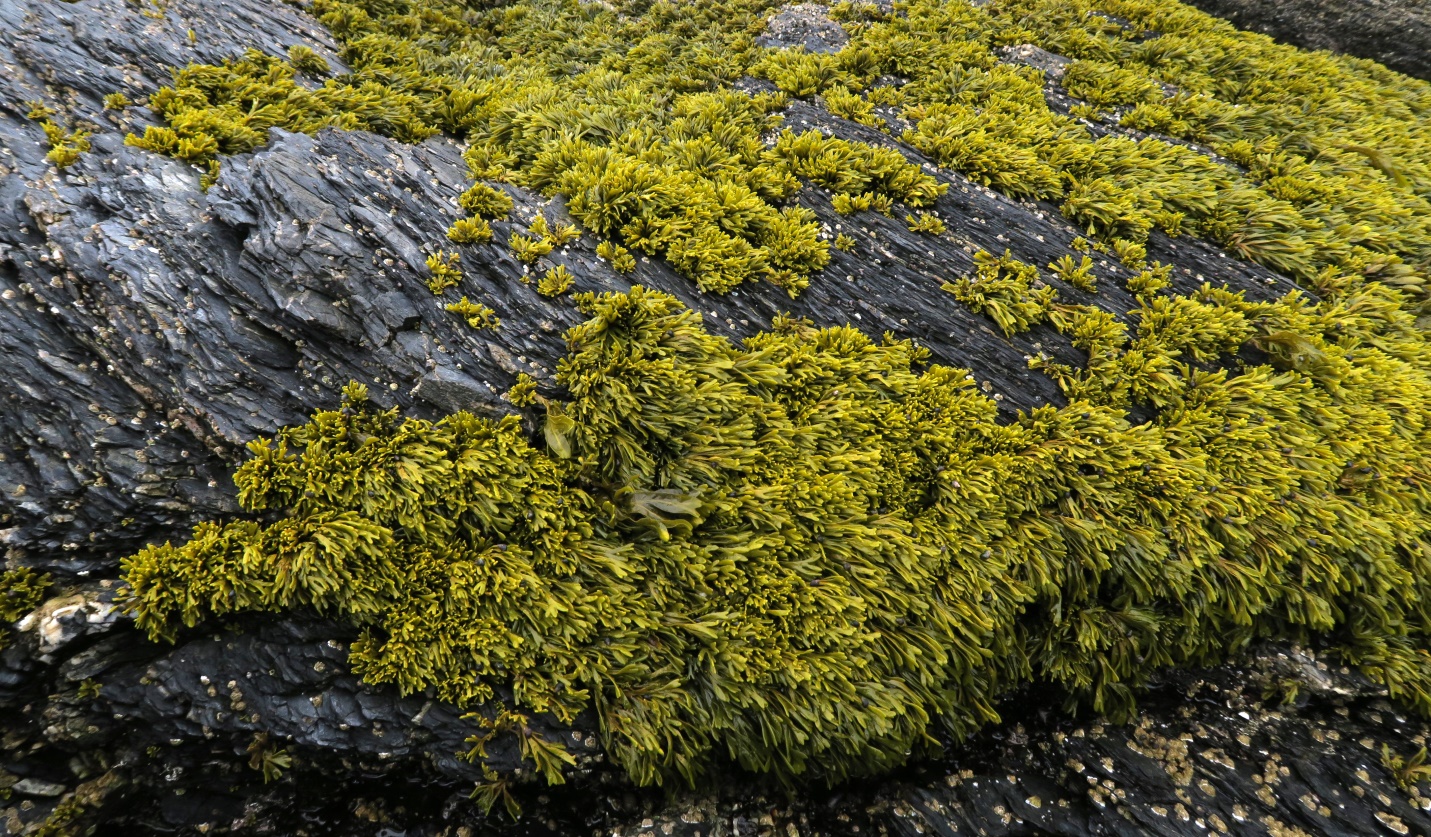
Figure 3: A springtime visit reveals this population of Pelvetiopsis limitata doing very well, indeed. At this upper littoral level, Dwarf Rockweed is often the only macro algae growing. While biology tells that this species is perennial, some circumstances obviously cause it to fail; a second visit to this exact area one year later revealed no Dwarf Rockweed at all. Botany Bay, Juan de Fuca Strait, B.C., Canada. June 11, 2020. Photo ID 27363 ©Seaweedwhisperings.com
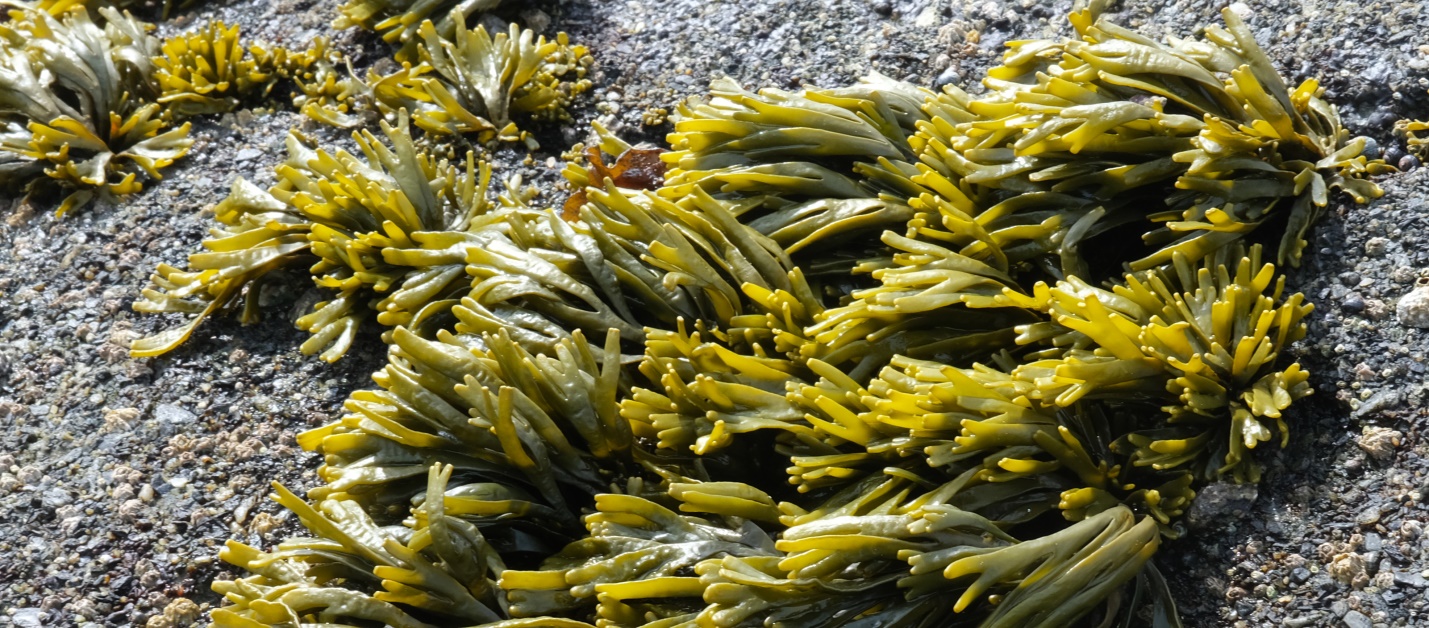
Figure 4: A closer view of a cluster of Pelvetiopsis limitata shows its growth habit. These individuals are not yet showing many warty receptacles and are therefore only just reaching reproductive maturity. Botany Bay, Juan de Fuca Strait, B.C., Canada. May 17, 2022. Photo ID 27364 ©Seaweedwhisperings.com
Person 2:
ROCK-weed, indeed! Whenever we find you it is way up in the high intertidal area growing as you do in groupings affixed directly to rock. It is mainly you and the rocks, plus some barnacles up here.
It was a delight to find you again this visit, as on our spring outing to this area you were distinctly absent from where we’d found you the previous June (2020). This spring I remember being quite astonished that such a large and healthy group of you would have vanished.
Do you do that? Make a splash, a vibrant show, and then have no staying power…, always destined to leave not a mark, no evidence of your presence after your time.
This day in early December Person 1 found you, and indeed the first grouping was a smaller ‘clan’, but there you were, hanging on the leeward and ‘surf-ward’ side of a large prominence of exposed sandstone that reaches into the strait here. You were sharing ‘real estate’ with Mastocarpus, both foliose and crust forms, and a few barnacles and limpets. There was also a wee bit of Fucus distichus mixed in which was handy for comparison identification purposes.
DWARF Rockweed, you certainly are smaller by comparison to Rockweed, Fucus distichus.
You don’t actually seem all that similar to Fucus; your olive yellow-green coloration is alike, but Pelvetiopsis, are narrow and your fork tipped thalli are also narrow. And while your stems are somewhat flattened, they are also thick, certainly thicker than Fucus distichus.
It seems to me that you have a simple design.
It is low maintenance.
It looks quite sturdy.
Except you seem to droop, or perhaps I should say lean. Yes, you’re leaning against each other, or against nearby algae or rock contours. Why spend the effort to stand up on your own? That’s inefficient and really not necessary it seems.
And since you seem only to live up here, high up in the intertidal zone, you don’t get immersed by the sea very much, certainly in comparison to most other macro algae. In the ‘splash zone’ you need to endure potential desiccation and longer intervals between opportunities to take in nutrients.
Your texture is thickened and it reminds me of the land plant grouping named succulents. Pelvetiopsis, with your thicker, waxy looking thalli it seems that you’re the algal version of succulent.
You can wait out the elements.
And you don’t appear needy or hard done by while you do that.
You actually look rather laid back about it all; some might even label you as lazy.
I laughed out loud when I reviewed one photo I’d made of you (Figure 1). Caught just as the sun was low and lit you through with a glowing golden light, the form of these young thalli reminded me of a 60’s era young person holding up their fingers in the “peace” symbol. Then I thought, yes, this Pelvetiopsis character would say “Peace, man, peace”, in a lazy drawl of a voice, but also behind that statement he’d think, but “don’t make me work for it”. Why not? Well, the idea for Pelvetiopsis is that “I’m fully absorbed in hanging about”, sometimes mildly stoned, but definitely not ambitious as regards any philosophies I may espouse!
The color of Pelvetiopsis limitata reminds me of some army ‘fatigues’ or uniforms – many of which range in colors similar to drab olive green. But I think Pelvetiopsis you would not be good “soldier material”, certainly not an elite soldier. It’s too much hard work to be in training and engaged in active deployments. I do think, however, you’d be well suited to the situation of “waiting for orders” – amassed somewhere near a battle zone, you might be among the unwilling recruits sent in as first invaders, destined, many of you, to perish – a strategic sacrifice to create openings for more skilled regiments, or simply fresh troops to advance the cause.
This is highly unusual for me. I don’t think / read / research war histories or battle strategies, but this has definitely come up for me in relation to Pelvetiopsis limitata.
The forked tips and fanned out thalli, even when flopped over on the rocks have a feel like maybe there’s a desire to reach out and connect with others as in, “Hey, buddy, let’s grab a beer, sit out on the porch and ‘shoot the breeze’ a while…, maybe get to know one another?” But this seaweed all grows to the same general height preferably in large groupings, so it is also amusing to consider just which outstretched hand would you shake and respond to saying, “Sure, I’d like that.”
Is there individuality in all that sameness of appearance? It’s certainly not readily apparent.
The term “shoot the breeze” is also not in my lexicon of daily language. It fits the energy of this seaweed very well. There’s no sense of hurry or pressure in its energy. It is laid back and very content to be so. The expression, shoot the breeze, defined as I sense its match with Pelvetiopsis is: to chat or converse aimlessly or casually about unimportant things often for a long period of time.
The “aimless talk of casual or unimportant things” may seem rather low in ambition, but the friendly chatting with another, shooting the breeze, is a warm and wholehearted expression of this seaweed’s companionability and energy.
When I observed some of the groupings of Dwarf Rockweed in situ, and I believe this effect shows in the photo labelled Figure 2, there can be a look that might make you wonder if it is upside down, or not oriented as you’d expect, or even falling away…….. There’s a look perhaps as if they have a different orientation, not so much as if they defy gravity, but they certainly “hang out” differently. Even where the Pelvetiopsis and the foliose form of Mastocarpus (Figure 5) are growing side by side, somehow the Mastocarpus seems to have a fitting orientation, whereas that is not so much the case for the feel of Pelvetiopsis.
Perhaps it is that Pelvetiopsis themselves doesn’t know how to “fit in” or “orient” themselves as many others seem to so easily do. Their energy differs obviously from societal norms. They’re not pretentious about it or about much of anything actually, but they simply orient themselves as suits them best and this is often notably different. They’re casual about this, too, don’t mind really at all how it looks to others, and they don’t exert pressure on others to ‘convert’ or join them – they’re simply relaxed and easy and comfortable in their ways.
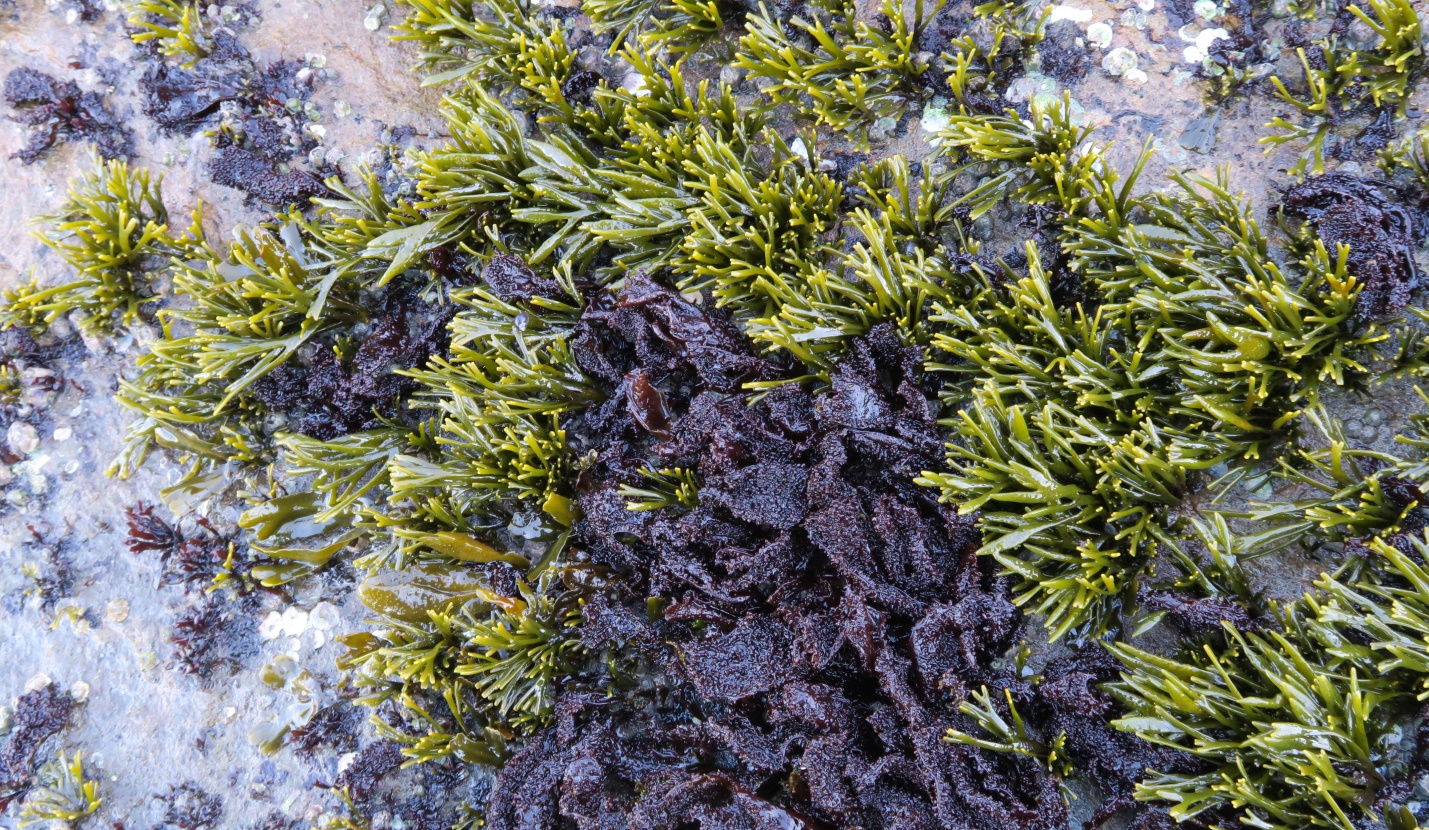
Figure 5: Growing alongside some healthy Mastocarpus thalli (the deep red algae at photo center) this grouping of Pelvetiopsis limitata is displaying its ‘winter’ look. Botany Bay, Juan de Fuca Strait, B.C., Canada. December 4, 2021. Photo ID 27365 ©Seaweedwhisperings.com
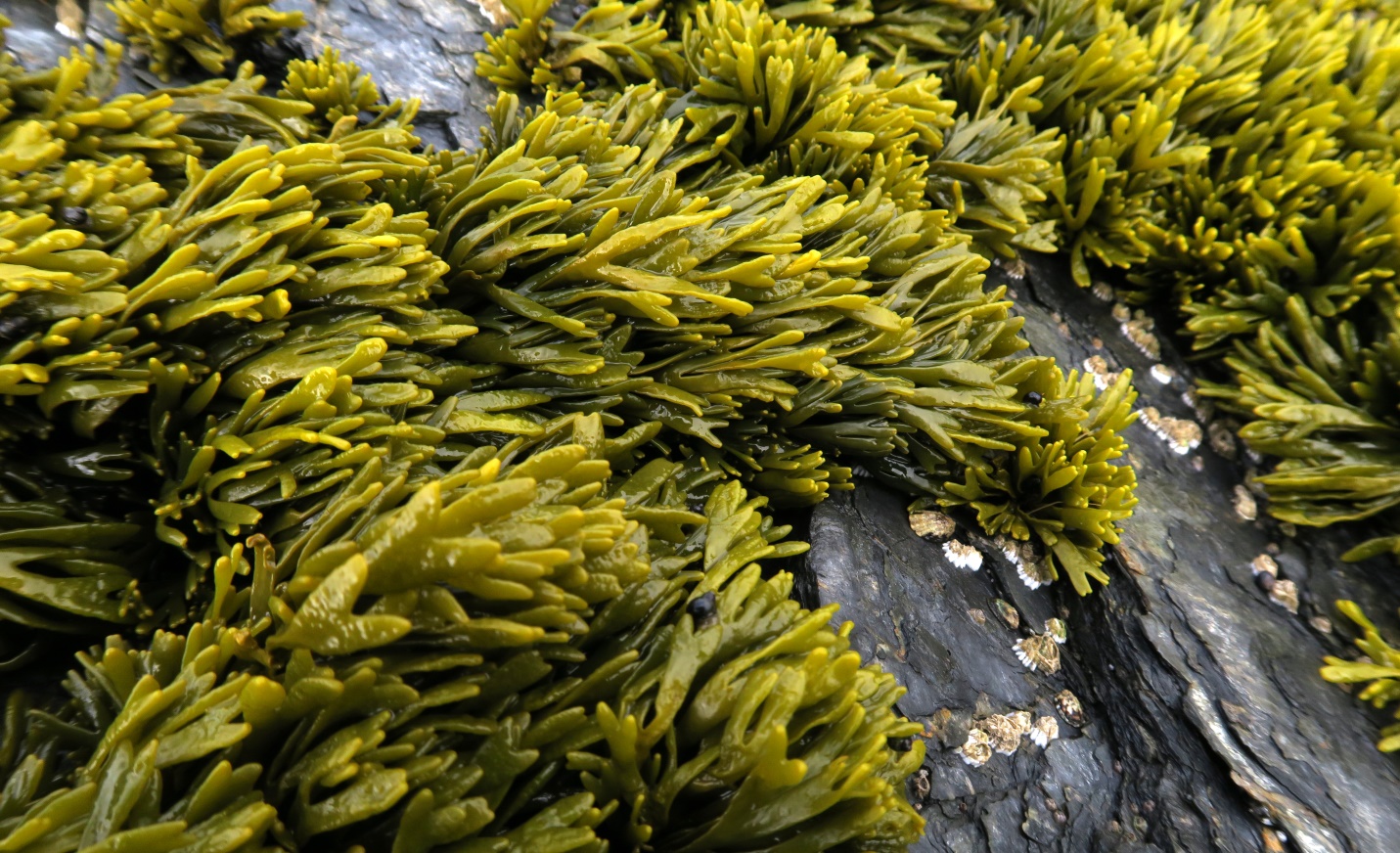
Figure 6: Reaching and leaning to the side, this thick group of Dwarf Rockweed is thriving. Botany Bay, Juan de Fuca Strait, B.C., Canada. June 11, 2020. Photo ID 27366 ©Seaweedwhisperings.com
Discussion:
Vanished from previous year’s rocky location completely – this brought up the following points:
Transient, doesn’t always “stick around”, chooses to move on when conditions aren’t ideal, when comfort diminishes. The ideal for them is living free from the rules and expectations of others.
They don’t set up colonies with the ideal of permanence, wouldn’t be motivated to build “the pyramids” (although they might be conscripted as laborers to do the work) but in terms of personal effort they might just get a palm thatched hut set up if they really needed the shelter. There seems to be little motivation to embark on or to complete a project of much size and not much desire to compete with others either.
Vanished or disappeared..., this concept also seems like it can show up as an issue in some relationships, too. So, while Pelvetiopsis may espouse some very fine ideas while they ‘shoot the breeze’ with others, those same others can become quite disappointed and frustrated to find out that Pelvetiopsis often DOES nothing much more than talk about their fine ideas. They have little intention of personally engaging in the work of manifesting such concepts.
Pondering on the “peace” hand gesture and “peace, man” sentiment and contrasting it with the soldiers and battle strategy thoughts, we did a quick bit of checking. The ‘V’ sign, made by holding up one’s index and middle fingers with the palm facing outward to the observer, initially was used to signal victory by Allied nations during World War II. During the Vietnam War in the 1960’s this same symbol was adopted by the anti-war/counterculture as a symbol of peace. Still today in the United States this gesture is known as the “peace sign”. So, a symbol once a signal for victorious soldiers at the culmination of war became the symbol for those who would not go to war. The Whispering captured hints mainly of the ‘peace’ aspect of this duality, but how much of the team effort ‘victorious’ nature resides as potential also in Pelvetiopsis? Or, is the point more that the nature of this energy is to transform aggressive, competitive and conquest-seeking energy to one that is rooted in contentment with what you have and a genuine personal peace?
The energy of this seaweed is laid back and friendly. It is not particularly, and certainly not dominantly, outwardly ambitious at all. You could say there is a ‘want of purpose’ to it or a ‘weak will’ aspect, but this same ‘aimlessness’ can really be experienced as a positive thing in the context of this energy. A very different emphasis is happening here and it is not anything to do with attaining and maintaining a position of success or achievement. That is hard work! It requires consistent and committed dedication to one’s goal or project. Pelvetiopsis limitata has the innate priority to relax and enjoy where they are and how they are. After all, with a turn of the seasons they may be gone, having left nary a trace of their existence on the tops of their surf swept high intertidal rock habitat.
Upon reviewing this last paragraph we paused to question, is that last sentence too dramatic for this seaweed? But upon reflection we thought, no, Pelvetiopsis could be quite the talented songwriter or poet but they would not always actually write it down, publish it or cut an album, etcetera. As reporters of this energy, we are taking that step for Pelvetiopsis.
Afterword:
A helpful coincidence occurred while editing this document for posting to the website. While searching for synonyms of “aimlessness” several links were found including one to “aimlessness Buddhism”. One source found is a website that shares the teachings of a Vietnamese Buddhist monk, Thich Nhat Hahn. There is a page on “aimlessness” which in the Buddhist translation can also mean “wishlessness”. The teaching there is about the value of not always being “goal-oriented”; that we might not tell ourselves quite so often “Don’t just sit there, do something!” but also consider when it is of value to stop and say, “Don’t just do something, sit there!” The energy of this particular seaweed, Pelvetiopsis limitata, is well-versed in this awareness.
It is also noteworthy that this particular monk has a direct tie with the country of Vietnam and indeed the Vietnam War. The era of this conflict, along with some concepts around military action and peace symbols and those unwilling to go to war, all showed up in our Whispering, as well. Thich Nhat Hahn was nominated for the Nobel Peace Prize in 1967 by Martin Luther King Jr. His efforts to undermine the violence affecting his people caused both non-communist and communist governments to ban him, and since 1966 he has been living in exile from his native Vietnam.
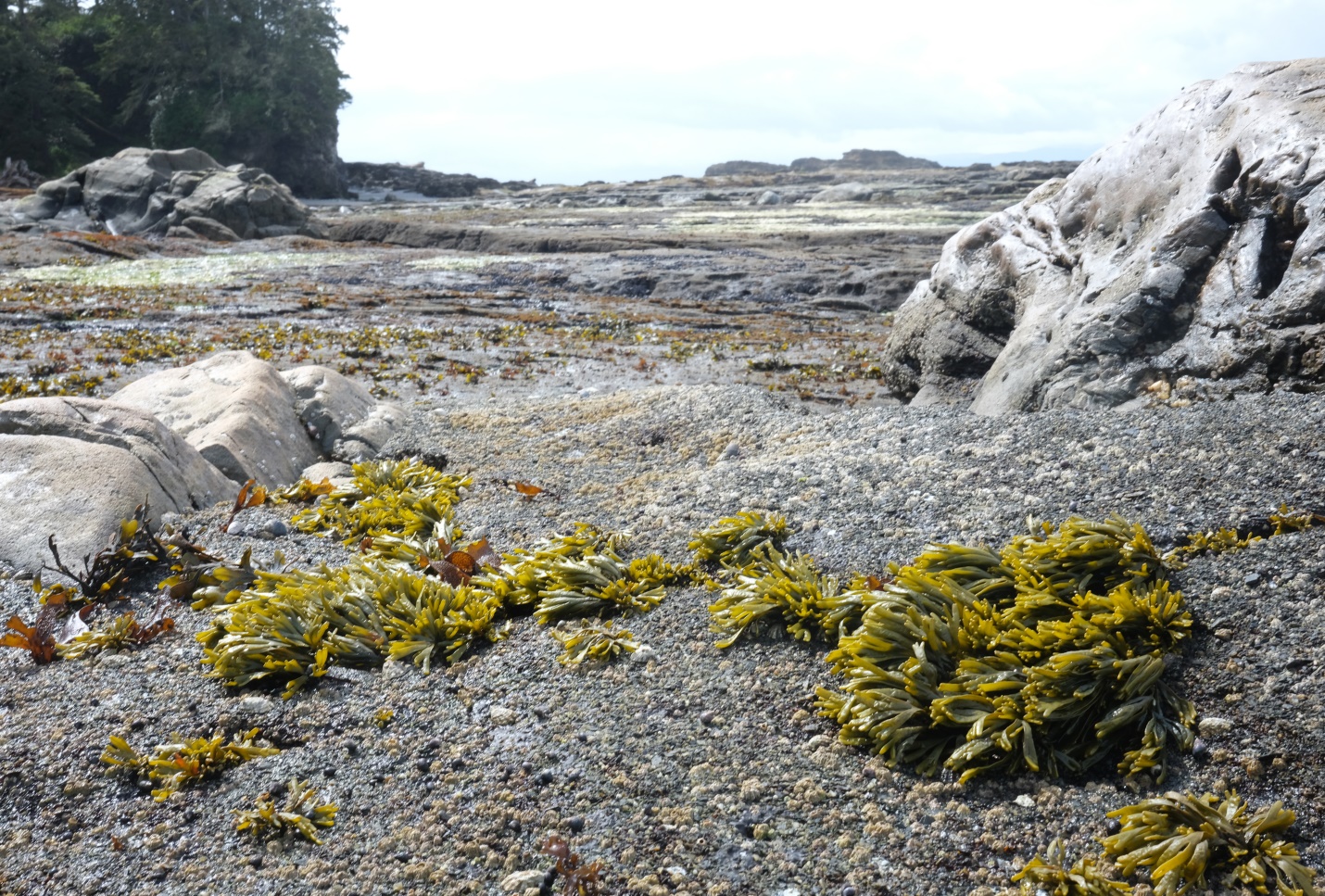
Figure 7: The “view” looking down towards the beach from up high on the surrounding rocks – this is the habitat and ‘perspective’ of Pelvelitopsis limitata. Botany Bay, Juan de Fuca Strait, B.C., Canada. May 17, 2022. Photo ID 27367 ©Seaweedwhisperings.com
Biology & Natural History Information:
Description:
The flattened, dichotomously branched thallus arises from a conical holdfast, has no midrib, is olive green to light tan in color, and grows 8 to 15 cm tall, though usually to less than 10 cm. The branches are cylindrical at their base but are flattened and oval in cross-section above. The branches lie mostly in one plane, and are only 2 to 4 mm wide. Inflated, warty receptacles are present on the tips of the ultimate dichotomies of mature branches. Both male and female reproductive organs can be found on a single seaweed of this perennial species.
Habitat:
Pelvetiopsis limitata finds its niche on rock of the high intertidal on wave exposed shorelines. It grows in the upper littoral above the Fucus zone and can occupy the slightly lower intertidal position alongside Fucus but Pelvetiopsis is more successful than Fucus in fully wave exposed areas.
Distribution:
Vancouver Island, British Columbia to San Luis Obispo County of central California.
Remarks:
This species is named for a French botanist, Dr. Pelvet. This is the type species, holotype, of the genus Pelvetiopsis.
Classification:
Phylum: Ochrophyta
Class: Phaeophyceae
Order: Fucales
Family: Fucaceae
Genus: Pelvetiopsis
Species: Pelvetiopsis limitata (Setchell) N.L.Gardner 1910
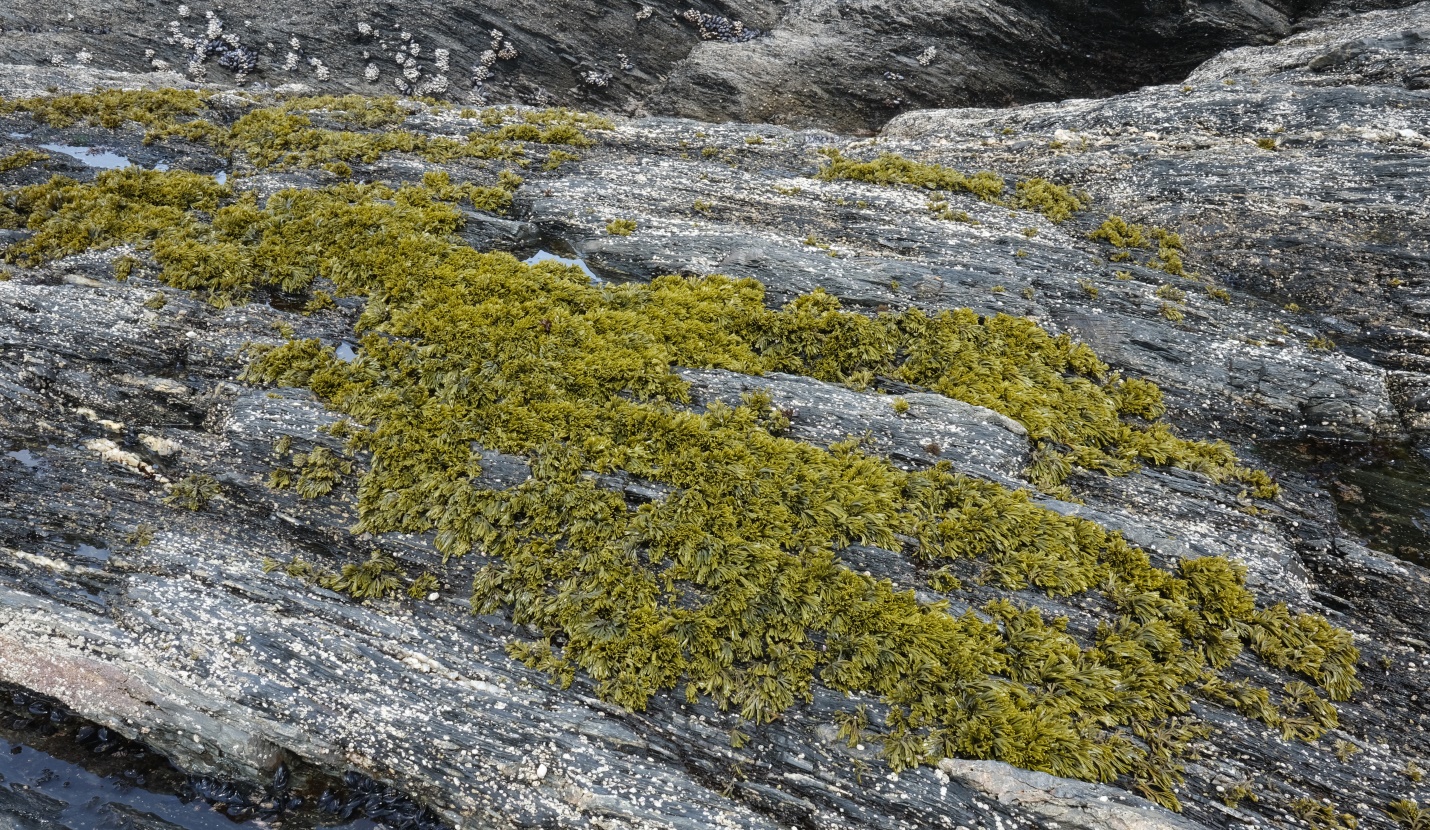
Figure 8: Another expanse of surf-exposed bedrock is carpeted with a strong showing of Pelvelitopsis limitata. Dwarf Rockweed is adapted to thrive in these wave-swept rocky areas, and cannot be found elsewhere. Botany Bay, Juan de Fuca Strait, B.C., Canada. May 17, 2022. Photo ID 27368 ©Seaweedwhisperings.com
![]()